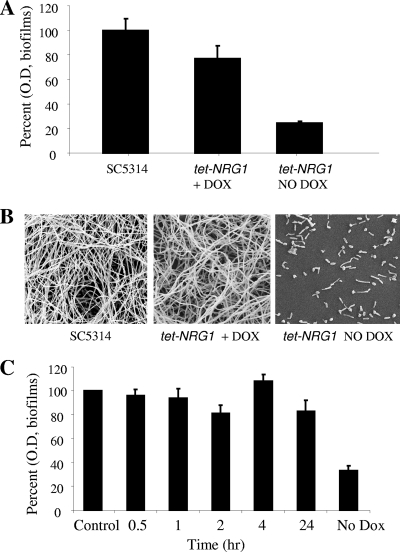Fig. 1.
Biofilm formation in the C. albicans tet-NRG1 strain occurs only in the presence of DOX, and not in the absence of the antibiotic when NRG1 is overexpressed. (A) Biofilm formation by the C. albicans wild-type strain (SC5314) in the absence of DOX and by the tet-NRG1 strain in the presence (20 μg/ml) or absence of DOX. Biofilms were formed in 96-well mictrotiter plates under biofilm-inducing conditions with suspensions of 1.0 × 106 cells/ml in RPMI and incubated at 37°C for 24 h. The extent of biofilm formation was estimated using the XTT colorimetric reduction assay. Results are expressed as percent OD readings compared to wild-type SC5314 biofilms. (B) The extent of biofilm formation by SC5314 and tet-NRG1 was further visualized by scanning electron microscopy. (C) C. albicans strain tet-NRG1 is capable of forming biofilms when DOX is added to medium after initial attachment of yeast cells. Yeast cells of the tet-NRG1 strain were allowed to adhere to the surface of wells in microtiter plates for 30 min and 1, 2, 4, and 24 h before the wells were washed with PBS and fresh medium containing DOX was added to the wells. After addition of the antibiotic-containing medium, plates were then incubated for an additional 24 h at 37°C. Biofilms were processed using the XTT reduction assay. Results are expressed as the percent OD readings compared to those of control biofilms obtained with the C. albicans tet-NRG1 strain grown in the continuous presence of DOX from the zero time point.

